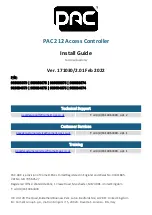
Installation, Operating & Maintenance instructions
PAGE 10
CCW until the protrusion flats hit the adjustment
screwsand the grooves line up with the threaded holes
as shown below.
See illustrations in section 6.3.
8.5
Fit the disc bearing (16) to the pinion.
8.6
Always use a new circlip (17). Insert it on the pinion.
If the pinion does not protrude high enough, make sure
that the bottom thrust bearing tongue has properly
engaged into the body groove and the stop is recessed
in the body.
8.7
Place the assembled body with the pinion on the rig
with the adaptor for inserting the pistons back in the
cylinders.
Return to section 6.9
ACTUATOR TESTING
After completion of actuator assembly it is required to follow
these testing procedures to ensure the actuator has been
assembled correct and to minimize the risk of personal.
Pneumatic Leak Test
The pneumatic test checks there is no leakage across the
pistons or to environment.
Use commercial leak testing solution to check leakage to
atmosphere. It is acceptable to allow a small amount of
leakage to atmosphere. A bubble which breaks every 10
seconds is considered acceptable.
The leak testing pressure will be 80 psig (5.5 barg). Use a
calibrated pressure regulator to apply pressure to the actuator.
WARNING: Do not exceed the maximum operating pressure
rating listed on the nameplate.
Cycle the actuator at least 5 times to allow the seals to find
their position before commencing with the leak test.
Piston leakage
Any leakage across the piston is not acceptable.
1.0
Apply the pressure to port A and leave port B open.
2.0
Apply a leak testing soap solution to port B and check
for leakage.
3.0. For DA actuators repeat this applying pressure to port
B and check port A for leakage.
4.0
If leakage is observed, disassemble the actuator again
and check the seals, surface finish and cleanliness of
the internal parts to find the cause of leakage.
After doing the repair work, the leakage test must be
performed again.
External leakage
For SR actuators apply the pressure to port A and leave
port B open.
For DA actuators apply the pressure to port A and B.
After applying pressure, wait a few seconds to let the pistons
stabilize and then check for leakage. Apply the leak testing
solution to the pinion output. For DA actuators apply the
leak testing solution to the covers.
TM-36-01C-01/05-HA
(Loctite is a registered trademark of Loctite Corp.)






























